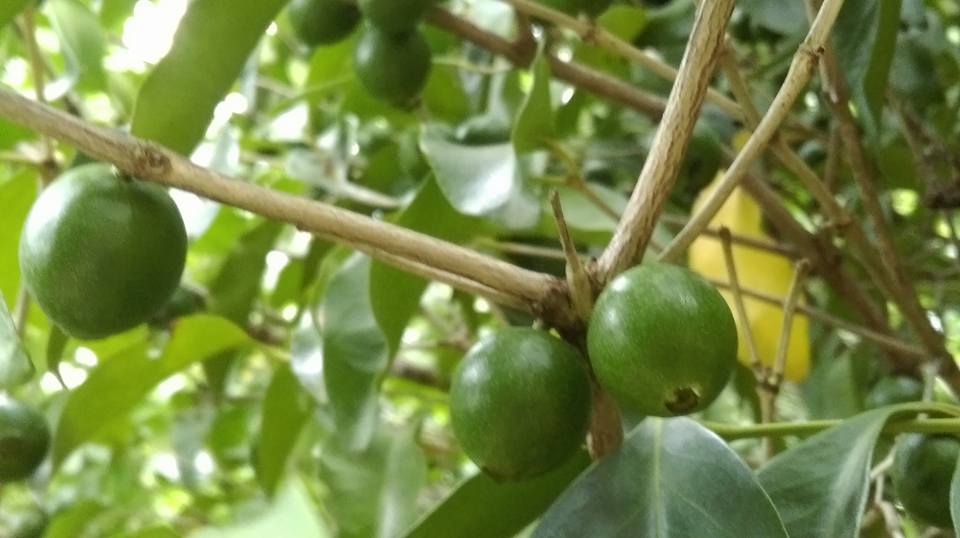|
Discospermum sphaerocarpum Dalzell ex Hook.f., Enum. Pl. Zeyl. 158 1859. (Syn: Diplospora dalzellii (Thwaites) Hook.f.; Diplospora sphaerocarpa (Dalzell ex Hook.f.) Hook.f.; Discospermum dalzellii Thwaites; Tricalysia dalzellii (Thwaites) Alston; Tricalysia sphaerocarpa (Dalzell ex Hook.f.) Gamble);
. Habit- Trees up to 15 m tall. Trunk\bark- Trunk flutted; bark whitish, smooth, fissured when mature; balze yellowish.
Branchlets- Young branchlets subterete to compressed, glabrous; apical bud usually exudes yellow resin.
Leaves- Leaves simple, opposite, decussate; stipules narrow triangular to 0.7 cm long, glabrous; petiole 0.6-1.5 cm long, slightly canaliculate above, glabrous; lamina 10-13 x 4-7 cm, elliptic to elliptic-ovate, apex acuminate with blunt tip or obtuse, base attenuate, margin entire, coriaceous, glabrous; midrib raised above; secondary nerves 5-8 pairs, hairy domatia present at axils; tertiary nerves broadly reticulate.
Flowers- Inflorescence axillary fascicles; flowers polygamodioecious, minute, sessile.
Fruit& seed- Berry globose, up to 2 cm long; seed many, flat.
Trees in evergreen forests up to1000 m.
Peninsular India; in the Western Ghats- South, Central and south Maharashtra Sahyadris.
Rubiaceae Tree for identification 261113MK001 : Attachments (3). 7 posts by 4 authors.
Please help me in identifying this small tree of Rubiaceae.
I thought this might be any Canthium sp. of Rubiaceae.
Fruit: c.3 cm across
Leaf: c. 8cm long; no fragrance or latex
Habitat: Dry Scrub forest and in village outskirts
Alt.: 200 – 300 m asl
Date: 06 Oct 2013 Can this be Catunaregam sp? Pls check for Tricalysia spherocarpa of Rubiaceae Yes it appears to be Catunaregam spinosa (Thunb.) Tirveng. It is not Catunaregam spinosa. Leaf and fruit are different from Catunaregam spinosa. For me also Tricalysia sphaerocarpa = Discospermum sphaerocarpum, as identified by … Tricalysia sphaerocarpa : 2 posts by 2 authors. Attachments (2)
Found in Auroville Botanical Garden, Tamil nadu in October.
ID please VV 120716- 1 : 2 posts by 2 authors. Attachments (2)
id please I don’t really think Mussaenda can be classified based on out of focus pictures of leaves ( and that too without measurements etc, surface pictures) and NO PICTURES OF THE so called flowers and the decorative “leaf guards”. This appears close to images and details at Discospermum sphaerocarpum Dalzell ex Hook.f.
. References: POWO The Plant List WCSP India Biodiversity Portal (Tricalysia sphaerocarpa (Dalz.) Gamble syn. Dicospermum sphaerocarpum Dalz.) Biotik (Tricalysia sphaerocarpa (Dalz.) Gamble syn. Dicospermum sphaerocarpum Dalz.) |
Disclaimer
1. For any mistake in identification or for becoming efloraofindia e-group member (for contributing towards building of efloraofindia or otherwise), pl. mail to indiantreepix@googlegroups.com or itpmods@googlegroups.com
2. For better viewing of species’ pages, colour scheme & formatting is being followed as: Description of the species, Details of other flora species on the same page, Uses/ harms, Distribution, Abundance/ Location/ Flowering time & date, Habit & habitat, Etymology & pronunciation, Other interesting information, stories etc., Others, Botanical names, Common names, Main point of discussion below, Discussion about Botanical names.
Navigation
- Award for eFloraofIndia
- Colour scheme & formatting
- Copyrights, Permissions, Citations
- eFloraofIndia appreciated
- Names of Plants in India site
- Flowersofindia site
- Posting Guidelines
- For members’ information
- Logo, Tagline, Acronym
- Volunteers required
- ‘Pitamah’ of eFloraofIndia
- ‘अजेय’ ‘Ajey’ of eFloraofIndia
- ‘Saarthi’ ‘सारथि’ of eFloraofIndia
- ‘Jewel’ of eFloraofIndia
- ‘Grassman’ of eFloraofIndia




